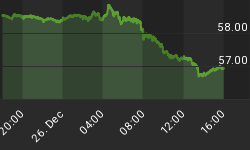"Meteorologist see perfect in strange things, and the meshing of three completely independent weather systems to form a hundred-year event is one of them. My God, thought Case, this is the perfect storm." - Sebastian Junger, The Perfect Storm

Far and away the biggest thorn in a reflatationist outlook has been the stalwart strength of the U.S. dollar since last July. Nautically speaking, it's been an everlasting red sunrise on the decks of those participants looking to navigate the narrows of the lost reflationary straits. Swiftly dumping the wind out of the sails of commodities and inflation expectations as they tacked higher in the first half of 2014, the thesis trade once again rolled over in heavy waters as rogue waves from the dollar surprised out of the southwest and made a strong move towards shore.
While the dollar found its sea legs at the top of the previous reflation cycle in the spring of 2011, it treaded water in a narrowing range for the better part of two years, alternating listless runs with the euro as both currencies floated towards a denouement in the third quarter of last year. Waking from its range with a thunder clap as the euro sank like Jonah - cast overboard and into troubled waters; resistance has been futile as the dollar has drawn broad support from the differentials in monetary policy, economic data and future policy expectations in the U.S.
Over the past few months we've contrasted comparative studies of previous deflationary (08/09') and disinflationary (85/86') markets, as the current trend attempts to exhaust. With the major central banks in the world making their respective policy pivots in the face of varying economic growth and with underlying disinflationary conditions broadly prevalent, conditions for the perfect storm in the dollar came together as rate hike expectations have continued to rise at home, Japan pauses and reflects on previous accommodations - and as Europe and China ease monetary policy once again. The net effects in the currency markets have provided a gale force wind behind the dollar, a listless drift in the yen and a swooning euro that has yet to find much traction, as it has in the past with major ECB initiatives intended to restore confidences in the eurozone.
With an echoed refrain of conditions witnessed in the summer of 2008, the moves in the dollar and euro since last summer had similar seasonal instigations with disinflationary cascades lower in commodities, yields and inflation expectations. However, it should be noted that during the financial crisis, conditions were broadly flamed in a risk-off environment - with the yen taking the safe have pole position and sharply bid higher. As mentioned in previous notes (see Here), this dynamic is diametrically opposite of the kinetic drive of the current market, which has generally been nurtured in a risk-on environment, with the dollar acting as its primary soldier of fortune and the yen playing possum in another round of carry the leader. In this regard, there are similarities in the currency markets with the buoyant conditions of the mid to late 1990's, where the dollar led the U.S. equity markets higher as traders piled into short positions in the yen, further dampening inflation expectations downstream.
While it's certainly an understatement that the dollar continues to exceed most upside expectations, similar to the summer of 1998, conditions are ripe in the currency markets for a significant reversal of trends. From our perspective, we're still of the opinion that old testament teachings will be taught, as we expect Jonah, the euro and yen to re-emerge from the whale.
For a chart series of referenced work, as well as other comparative studies, see Here.
















